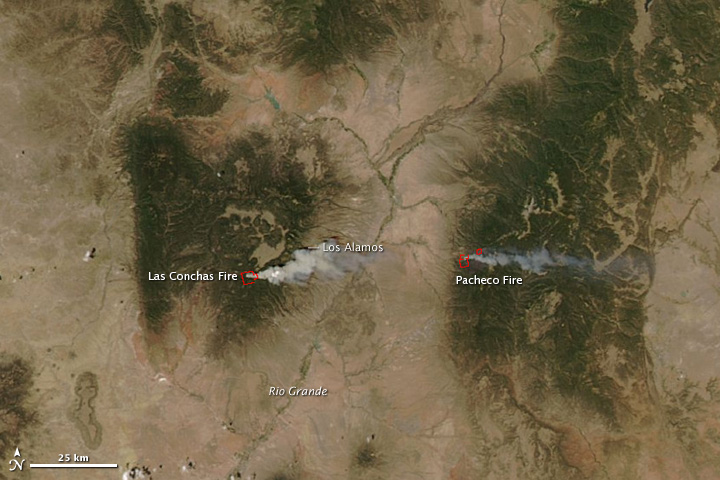(NASA doesn't seem to put images on this site in a timely manner so you can't use it to track reality, but they are instructive none-the-less).
Getting back to Las Conches, it too seems to be in the wind-down phase. No fat ladies are singing (outside of the opera house) yet, but Los Alamos and LANL are off evacuation notice. Yesterday an actual good map was posted and I grabbed a copy in case it got disappeared. Unfortunately it's embeded in a pdf document as small strips of image so you'll just have to download it and look at it as best you can: http://www.etantdonnes.com/HVFD/image/lasconches_ftp-20110701-153027.pdf. By comparing that map to the usual-schmutzy one from July 2 23:00 posted this morning you can get an idea of what's been affected and where -- it is hoped -- it will all end:
A Little Exegesis
A number of people have asked me, "How come they don't just fill up every airplane and drown the thing right away?" The problem is, you can't get enough water in the air to have any real effect. Let's just say that it would take a storm dumping 1" of rain in an hour to knock-down a square-mile of burning forest -- I'm just grabbing those numbers out of an orifice, but I think they're in the right ballpark. That storm would deliver around 18 million gallons of water. Most firefighting air tankers carry 3000 gallons or less, so you would need to execute 6000 drops in an hour to have the same effect. Thus air drops are generally used on small spot fires or to create containment lines with retardant.
Which brings me to a small lecture on wildfire fighting. The Fire Tetrahedron shows that you need four things for a fire to burn: Air, Fuel, Heat, and Chemistry. To stop the fire you need to interrupt continuity in one or more of those. For a structure fire you have a failrly well contained but very hot fire. You can deliver 10 or 20,000 gallons of water in an hour and basically drown it -- the water cools it off and to some extent limits the fuel's access to air. In a big wildland fire there's no way to cool it off, so the only thing you can do is limit it's access to fuel. This is called "cutting line" around the fire. We have to make a break in the continuity of fuel using natural barriers like ridge-tops and rivers as well as man-made roads, bull-dozed strips, and, very often, hand-dug trenches.
The three things of interest in a widlfire are: Fuel, Weather, and Topology. With heavy fuels -- big trees with jungle-like understory -- it's very hard to break the continuity. Windy, especially hot and dry, weather drives the fire and causes "spotting" -- embers blown far from the fire front which ignite new "spot fires" that can expand and spot some more. Rough terrain makes it very hard to access to cut-line and, since fire likes to travel up, the second worst place to be (the worst being IN the fire) is up-wind and up-hill -- which is exactly where you need to be in order to stop the main fire's progress and knock out those small spot fires. That's why these things take so long to get under control.
For Las Conches, it looks like really concentrated work saved the Pajarito Ski lodge buildings and, with some added weather luck, kept the fire from spreading into inhabited parts of Los Alamos. But that's using over 1000 people on only a small part of the fire-line.
Personal interest aside: I grew up near the SoCal air tanker base which this guy visited: Cal Fire Airtankers at Hemet-Ryan,CA so I well remember them flying overhead all day long during the summer.
 link
link
No comments:
Post a Comment